Taxation Law Assignment: Analysis of Tax Laws and Cases
VerifiedAdded on 2019/10/31
|14
|2942
|445
Homework Assignment
AI Summary
This taxation law assignment delves into several key areas of tax law. The assignment begins by analyzing whether a taxpayer can offset capital losses, referencing relevant sections of the ITAA 1997. It then explores the computation of Fringe Benefit Tax (FBT) under the Fringe Benefit Tax Act 1986, including relevant taxation rulings. The assignment further examines the distribution of losses in the context of rental property ownership, considering case law and taxation rulings. The fourth section addresses tax avoidance principles, referencing the IRC v Duke of Westminster case. Finally, the assignment evaluates the application of subsection 6 (1) of the ITAA 1997 concerning timber curtailment. Each section includes a discussion of the issue, relevant laws, applications, and conclusions.
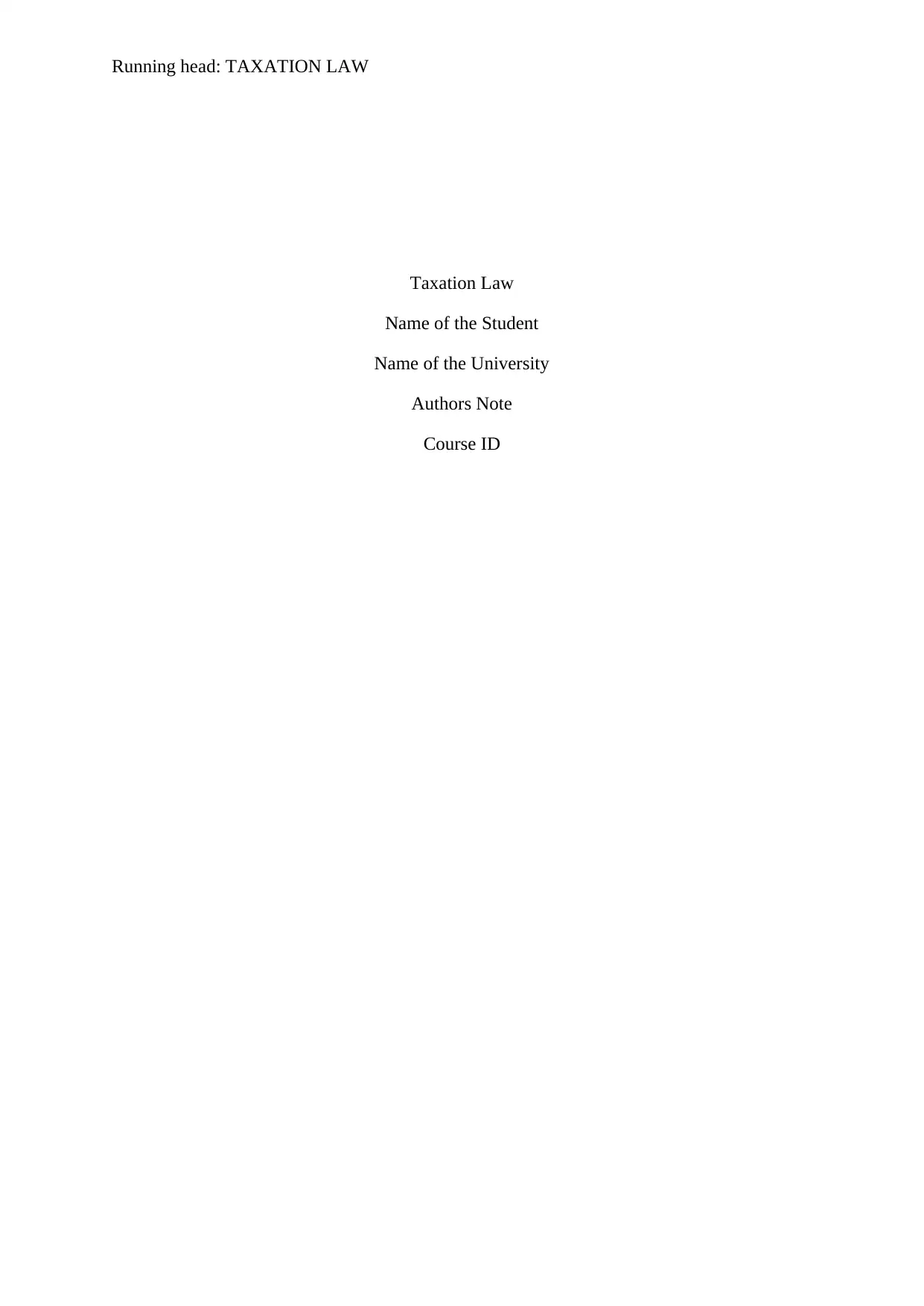
Running head: TAXATION LAW
Taxation Law
Name of the Student
Name of the University
Authors Note
Course ID
Taxation Law
Name of the Student
Name of the University
Authors Note
Course ID
Paraphrase This Document
Need a fresh take? Get an instant paraphrase of this document with our AI Paraphraser
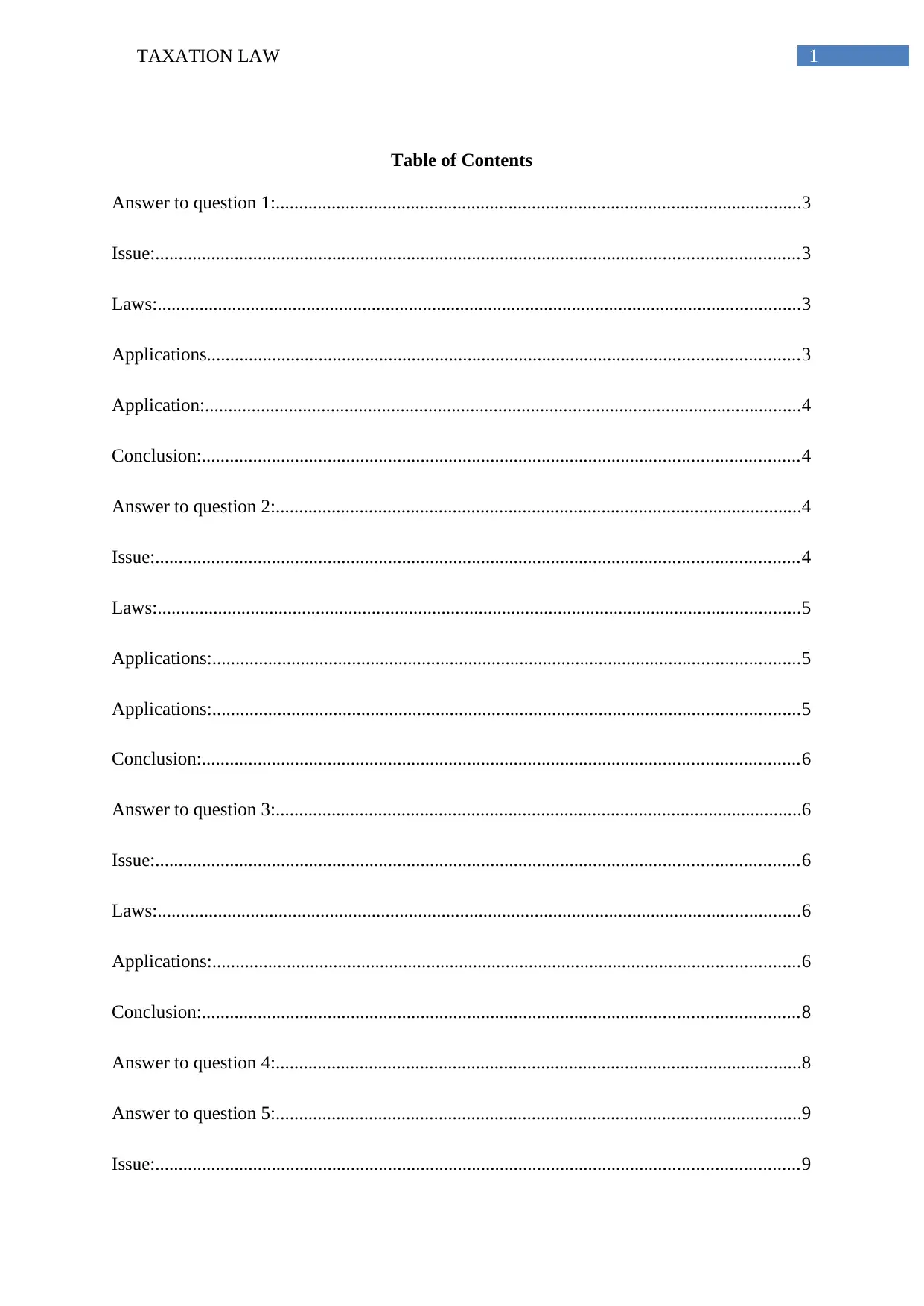
1TAXATION LAW
Table of Contents
Answer to question 1:.................................................................................................................3
Issue:..........................................................................................................................................3
Laws:..........................................................................................................................................3
Applications...............................................................................................................................3
Application:................................................................................................................................4
Conclusion:................................................................................................................................4
Answer to question 2:.................................................................................................................4
Issue:..........................................................................................................................................4
Laws:..........................................................................................................................................5
Applications:..............................................................................................................................5
Applications:..............................................................................................................................5
Conclusion:................................................................................................................................6
Answer to question 3:.................................................................................................................6
Issue:..........................................................................................................................................6
Laws:..........................................................................................................................................6
Applications:..............................................................................................................................6
Conclusion:................................................................................................................................8
Answer to question 4:.................................................................................................................8
Answer to question 5:.................................................................................................................9
Issue:..........................................................................................................................................9
Table of Contents
Answer to question 1:.................................................................................................................3
Issue:..........................................................................................................................................3
Laws:..........................................................................................................................................3
Applications...............................................................................................................................3
Application:................................................................................................................................4
Conclusion:................................................................................................................................4
Answer to question 2:.................................................................................................................4
Issue:..........................................................................................................................................4
Laws:..........................................................................................................................................5
Applications:..............................................................................................................................5
Applications:..............................................................................................................................5
Conclusion:................................................................................................................................6
Answer to question 3:.................................................................................................................6
Issue:..........................................................................................................................................6
Laws:..........................................................................................................................................6
Applications:..............................................................................................................................6
Conclusion:................................................................................................................................8
Answer to question 4:.................................................................................................................8
Answer to question 5:.................................................................................................................9
Issue:..........................................................................................................................................9
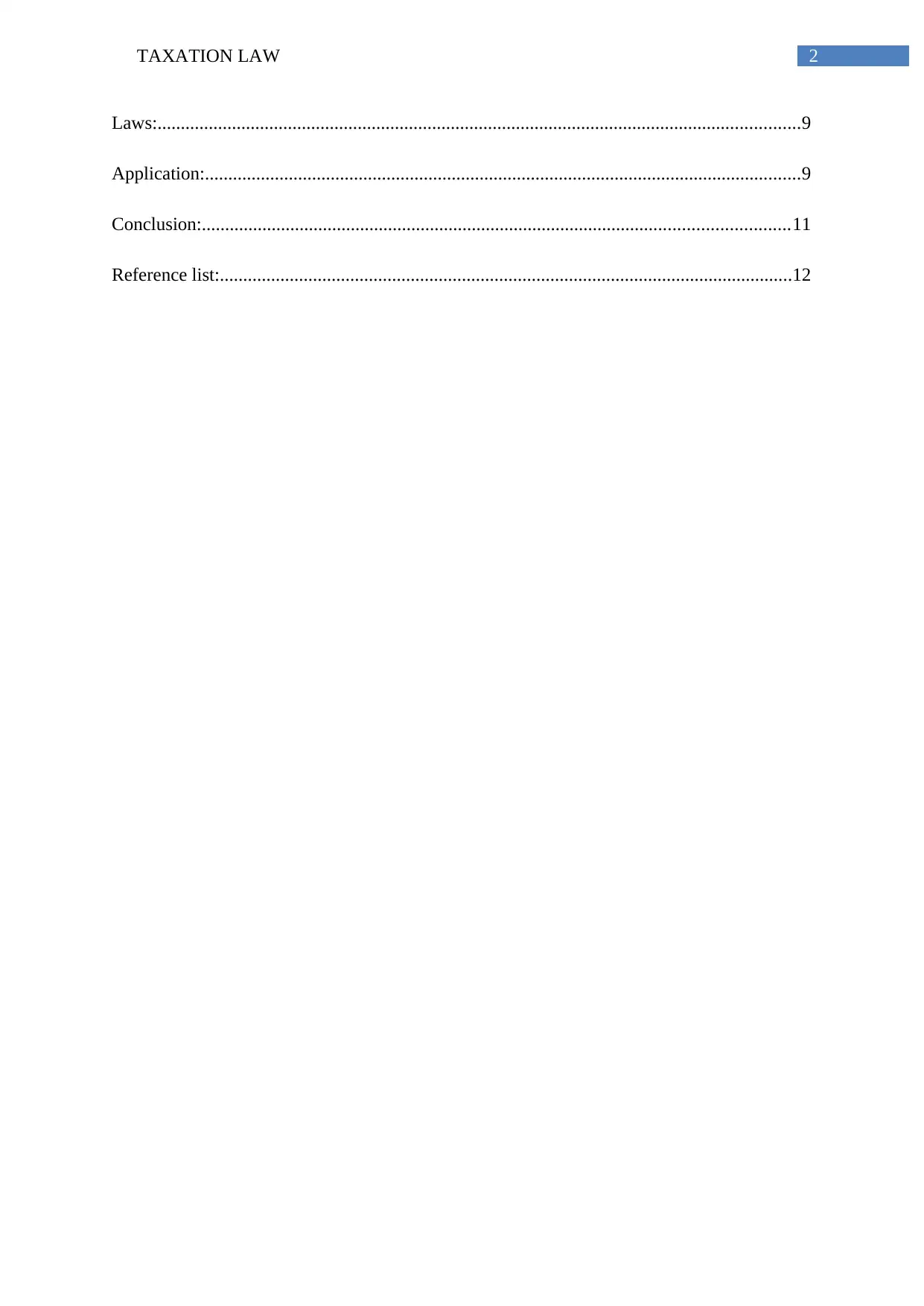
2TAXATION LAW
Laws:..........................................................................................................................................9
Application:................................................................................................................................9
Conclusion:..............................................................................................................................11
Reference list:...........................................................................................................................12
Laws:..........................................................................................................................................9
Application:................................................................................................................................9
Conclusion:..............................................................................................................................11
Reference list:...........................................................................................................................12
⊘ This is a preview!⊘
Do you want full access?
Subscribe today to unlock all pages.

Trusted by 1+ million students worldwide
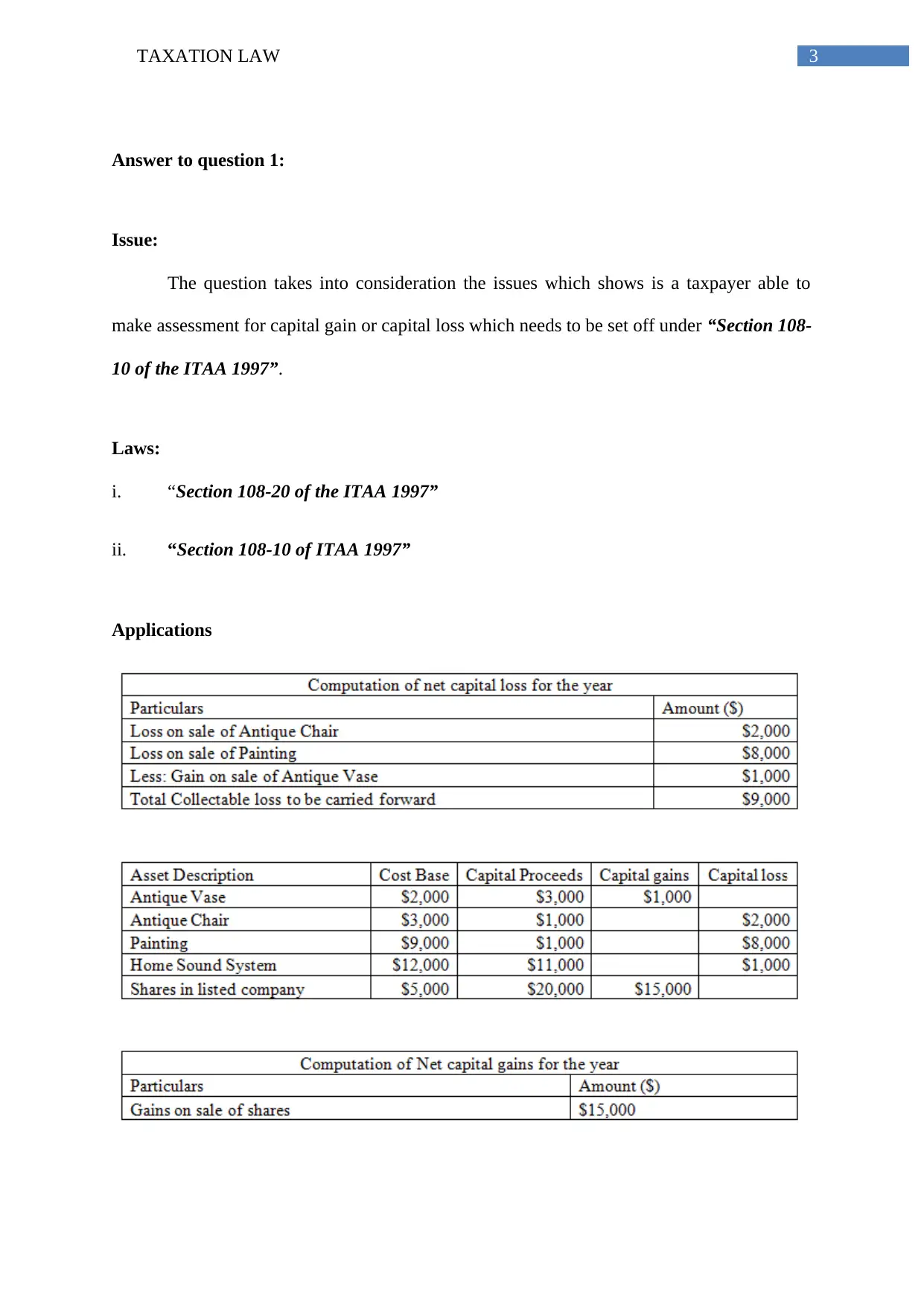
3TAXATION LAW
Answer to question 1:
Issue:
The question takes into consideration the issues which shows is a taxpayer able to
make assessment for capital gain or capital loss which needs to be set off under “Section 108-
10 of the ITAA 1997”.
Laws:
i. “Section 108-20 of the ITAA 1997”
ii. “Section 108-10 of ITAA 1997”
Applications
Answer to question 1:
Issue:
The question takes into consideration the issues which shows is a taxpayer able to
make assessment for capital gain or capital loss which needs to be set off under “Section 108-
10 of the ITAA 1997”.
Laws:
i. “Section 108-20 of the ITAA 1997”
ii. “Section 108-10 of ITAA 1997”
Applications
Paraphrase This Document
Need a fresh take? Get an instant paraphrase of this document with our AI Paraphraser
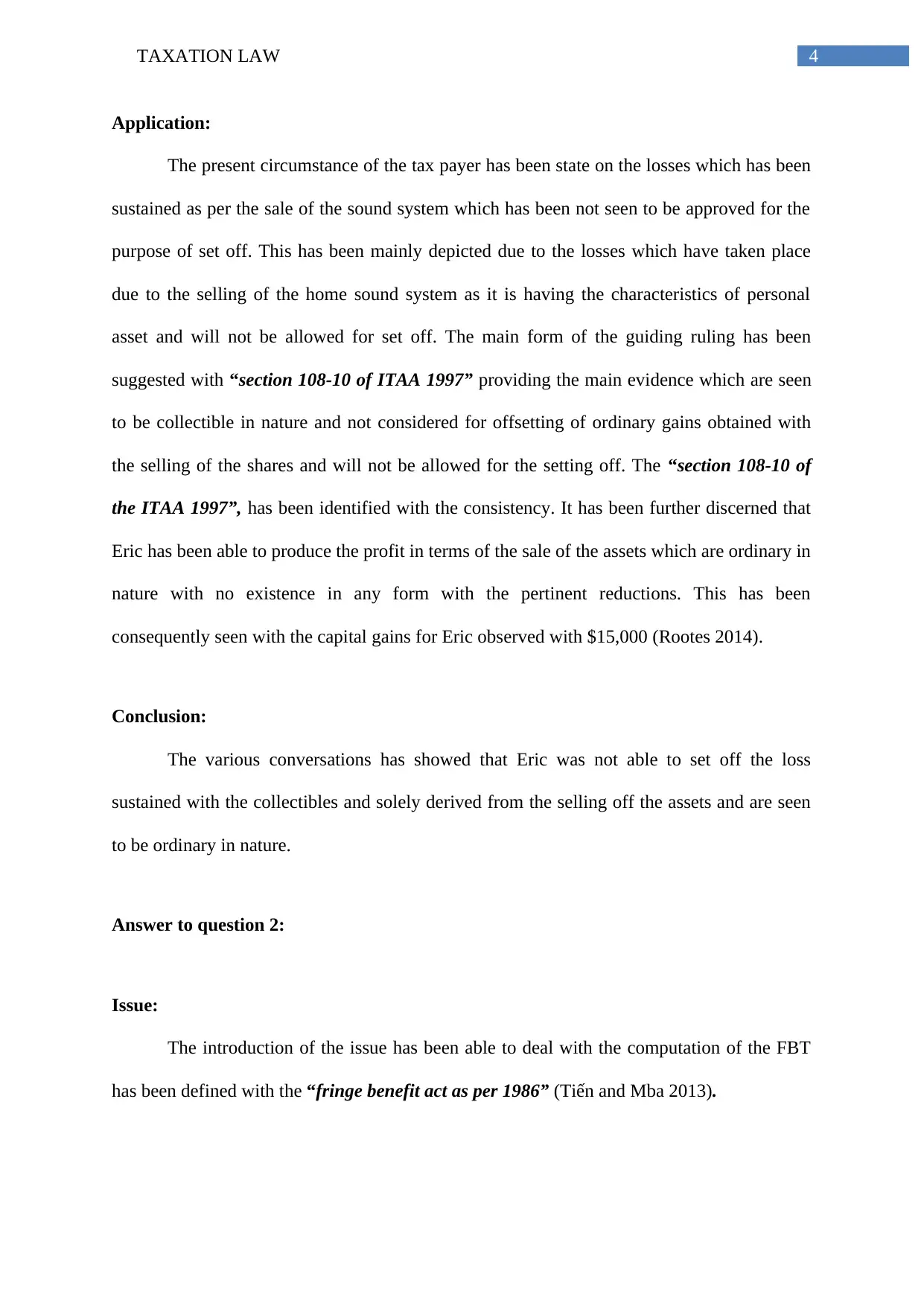
4TAXATION LAW
Application:
The present circumstance of the tax payer has been state on the losses which has been
sustained as per the sale of the sound system which has been not seen to be approved for the
purpose of set off. This has been mainly depicted due to the losses which have taken place
due to the selling of the home sound system as it is having the characteristics of personal
asset and will not be allowed for set off. The main form of the guiding ruling has been
suggested with “section 108-10 of ITAA 1997” providing the main evidence which are seen
to be collectible in nature and not considered for offsetting of ordinary gains obtained with
the selling of the shares and will not be allowed for the setting off. The “section 108-10 of
the ITAA 1997”, has been identified with the consistency. It has been further discerned that
Eric has been able to produce the profit in terms of the sale of the assets which are ordinary in
nature with no existence in any form with the pertinent reductions. This has been
consequently seen with the capital gains for Eric observed with $15,000 (Rootes 2014).
Conclusion:
The various conversations has showed that Eric was not able to set off the loss
sustained with the collectibles and solely derived from the selling off the assets and are seen
to be ordinary in nature.
Answer to question 2:
Issue:
The introduction of the issue has been able to deal with the computation of the FBT
has been defined with the “fringe benefit act as per 1986” (Tiến and Mba 2013).
Application:
The present circumstance of the tax payer has been state on the losses which has been
sustained as per the sale of the sound system which has been not seen to be approved for the
purpose of set off. This has been mainly depicted due to the losses which have taken place
due to the selling of the home sound system as it is having the characteristics of personal
asset and will not be allowed for set off. The main form of the guiding ruling has been
suggested with “section 108-10 of ITAA 1997” providing the main evidence which are seen
to be collectible in nature and not considered for offsetting of ordinary gains obtained with
the selling of the shares and will not be allowed for the setting off. The “section 108-10 of
the ITAA 1997”, has been identified with the consistency. It has been further discerned that
Eric has been able to produce the profit in terms of the sale of the assets which are ordinary in
nature with no existence in any form with the pertinent reductions. This has been
consequently seen with the capital gains for Eric observed with $15,000 (Rootes 2014).
Conclusion:
The various conversations has showed that Eric was not able to set off the loss
sustained with the collectibles and solely derived from the selling off the assets and are seen
to be ordinary in nature.
Answer to question 2:
Issue:
The introduction of the issue has been able to deal with the computation of the FBT
has been defined with the “fringe benefit act as per 1986” (Tiến and Mba 2013).
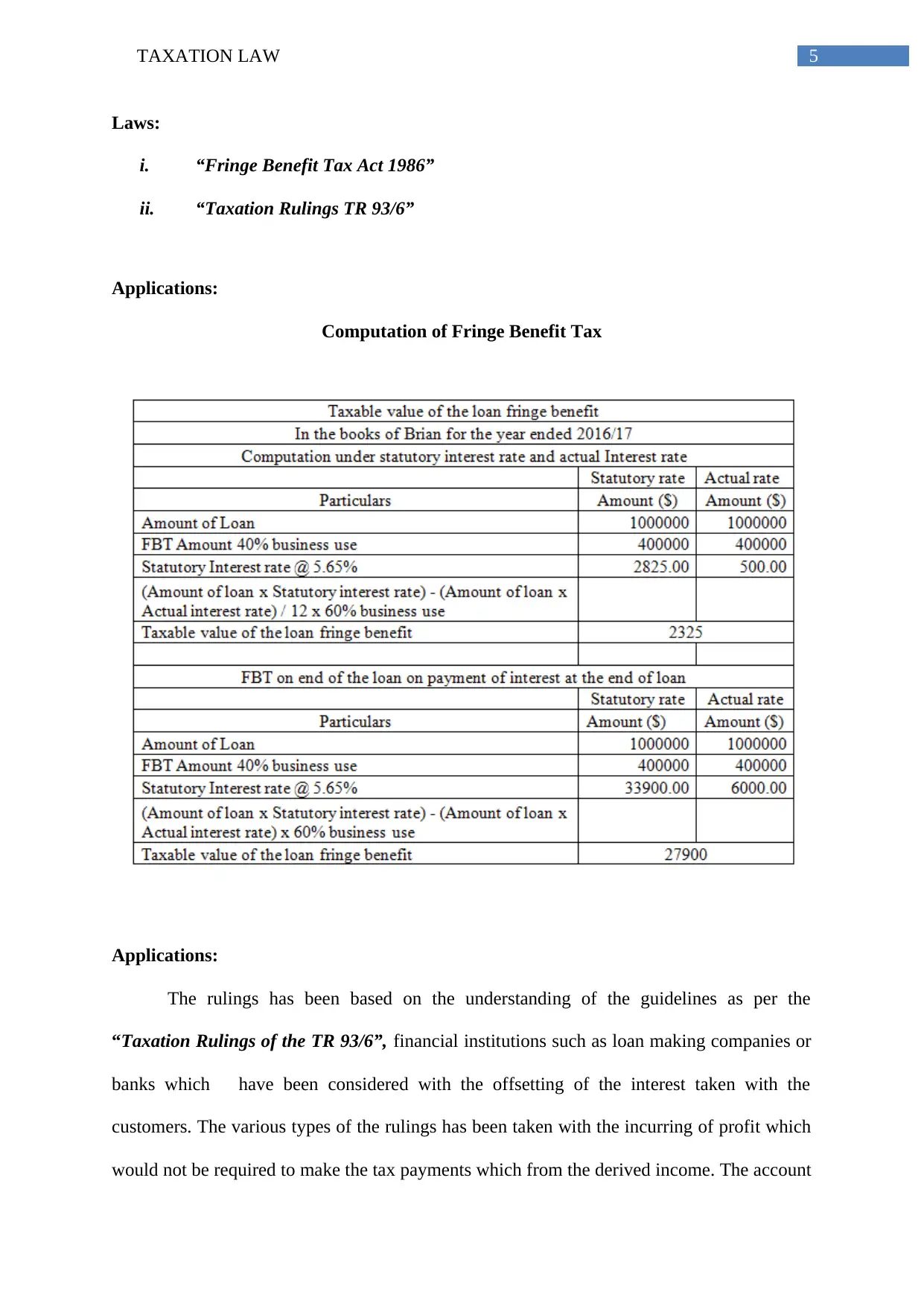
5TAXATION LAW
Laws:
i. “Fringe Benefit Tax Act 1986”
ii. “Taxation Rulings TR 93/6”
Applications:
Computation of Fringe Benefit Tax
Applications:
The rulings has been based on the understanding of the guidelines as per the
“Taxation Rulings of the TR 93/6”, financial institutions such as loan making companies or
banks which have been considered with the offsetting of the interest taken with the
customers. The various types of the rulings has been taken with the incurring of profit which
would not be required to make the tax payments which from the derived income. The account
Laws:
i. “Fringe Benefit Tax Act 1986”
ii. “Taxation Rulings TR 93/6”
Applications:
Computation of Fringe Benefit Tax
Applications:
The rulings has been based on the understanding of the guidelines as per the
“Taxation Rulings of the TR 93/6”, financial institutions such as loan making companies or
banks which have been considered with the offsetting of the interest taken with the
customers. The various types of the rulings has been taken with the incurring of profit which
would not be required to make the tax payments which from the derived income. The account
⊘ This is a preview!⊘
Do you want full access?
Subscribe today to unlock all pages.

Trusted by 1+ million students worldwide
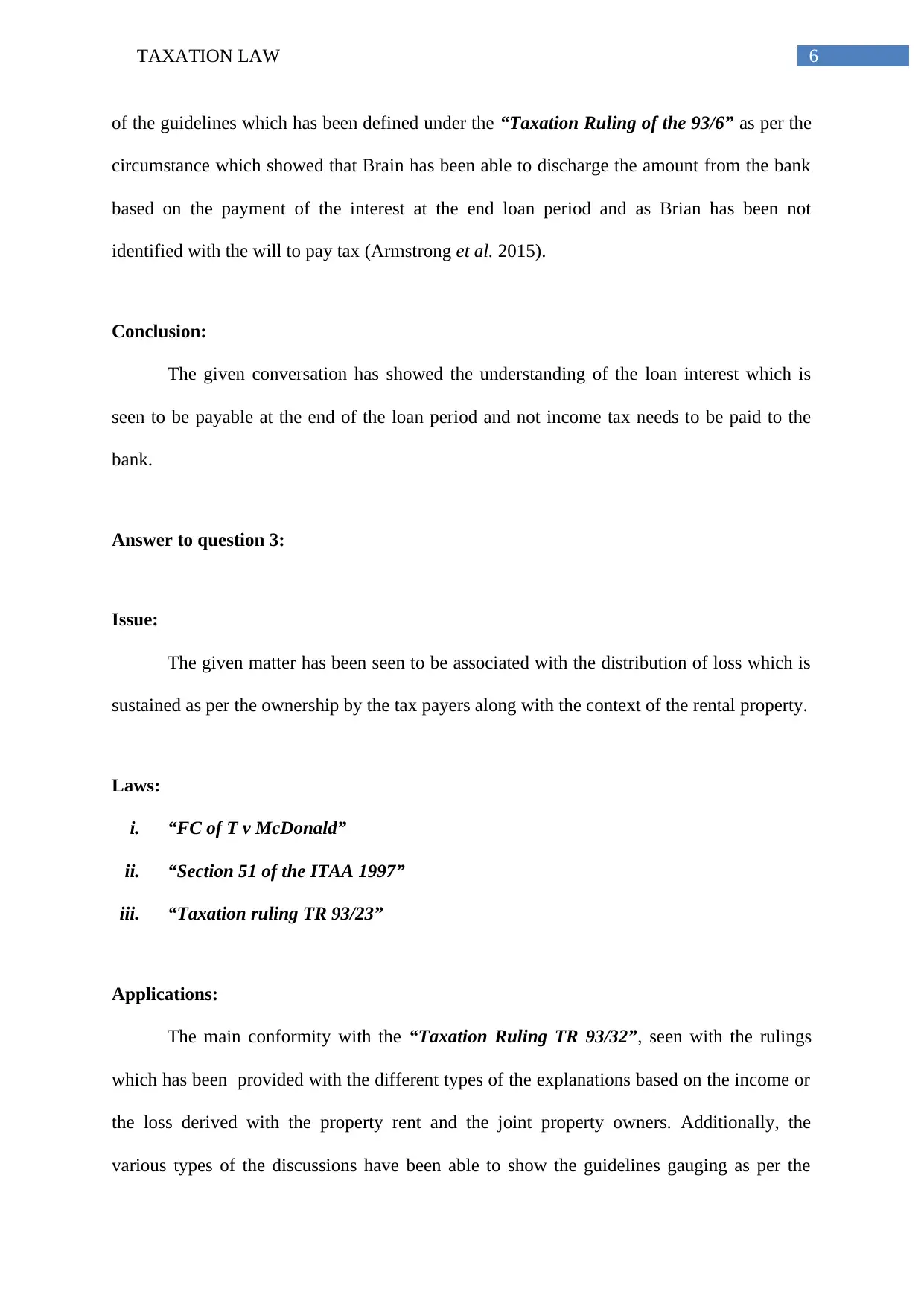
6TAXATION LAW
of the guidelines which has been defined under the “Taxation Ruling of the 93/6” as per the
circumstance which showed that Brain has been able to discharge the amount from the bank
based on the payment of the interest at the end loan period and as Brian has been not
identified with the will to pay tax (Armstrong et al. 2015).
Conclusion:
The given conversation has showed the understanding of the loan interest which is
seen to be payable at the end of the loan period and not income tax needs to be paid to the
bank.
Answer to question 3:
Issue:
The given matter has been seen to be associated with the distribution of loss which is
sustained as per the ownership by the tax payers along with the context of the rental property.
Laws:
i. “FC of T v McDonald”
ii. “Section 51 of the ITAA 1997”
iii. “Taxation ruling TR 93/23”
Applications:
The main conformity with the “Taxation Ruling TR 93/32”, seen with the rulings
which has been provided with the different types of the explanations based on the income or
the loss derived with the property rent and the joint property owners. Additionally, the
various types of the discussions have been able to show the guidelines gauging as per the
of the guidelines which has been defined under the “Taxation Ruling of the 93/6” as per the
circumstance which showed that Brain has been able to discharge the amount from the bank
based on the payment of the interest at the end loan period and as Brian has been not
identified with the will to pay tax (Armstrong et al. 2015).
Conclusion:
The given conversation has showed the understanding of the loan interest which is
seen to be payable at the end of the loan period and not income tax needs to be paid to the
bank.
Answer to question 3:
Issue:
The given matter has been seen to be associated with the distribution of loss which is
sustained as per the ownership by the tax payers along with the context of the rental property.
Laws:
i. “FC of T v McDonald”
ii. “Section 51 of the ITAA 1997”
iii. “Taxation ruling TR 93/23”
Applications:
The main conformity with the “Taxation Ruling TR 93/32”, seen with the rulings
which has been provided with the different types of the explanations based on the income or
the loss derived with the property rent and the joint property owners. Additionally, the
various types of the discussions have been able to show the guidelines gauging as per the
Paraphrase This Document
Need a fresh take? Get an instant paraphrase of this document with our AI Paraphraser
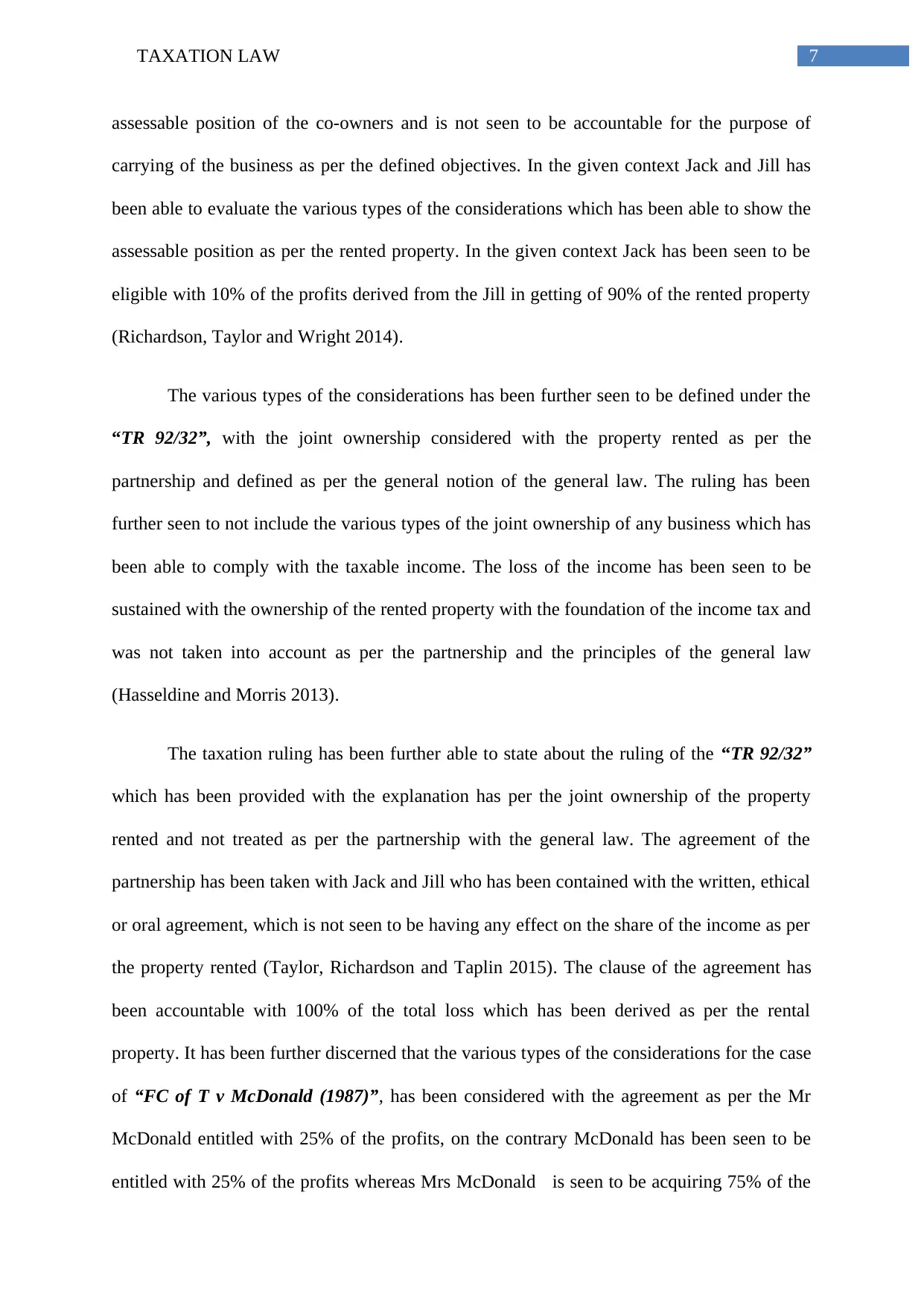
7TAXATION LAW
assessable position of the co-owners and is not seen to be accountable for the purpose of
carrying of the business as per the defined objectives. In the given context Jack and Jill has
been able to evaluate the various types of the considerations which has been able to show the
assessable position as per the rented property. In the given context Jack has been seen to be
eligible with 10% of the profits derived from the Jill in getting of 90% of the rented property
(Richardson, Taylor and Wright 2014).
The various types of the considerations has been further seen to be defined under the
“TR 92/32”, with the joint ownership considered with the property rented as per the
partnership and defined as per the general notion of the general law. The ruling has been
further seen to not include the various types of the joint ownership of any business which has
been able to comply with the taxable income. The loss of the income has been seen to be
sustained with the ownership of the rented property with the foundation of the income tax and
was not taken into account as per the partnership and the principles of the general law
(Hasseldine and Morris 2013).
The taxation ruling has been further able to state about the ruling of the “TR 92/32”
which has been provided with the explanation has per the joint ownership of the property
rented and not treated as per the partnership with the general law. The agreement of the
partnership has been taken with Jack and Jill who has been contained with the written, ethical
or oral agreement, which is not seen to be having any effect on the share of the income as per
the property rented (Taylor, Richardson and Taplin 2015). The clause of the agreement has
been accountable with 100% of the total loss which has been derived as per the rental
property. It has been further discerned that the various types of the considerations for the case
of “FC of T v McDonald (1987)”, has been considered with the agreement as per the Mr
McDonald entitled with 25% of the profits, on the contrary McDonald has been seen to be
entitled with 25% of the profits whereas Mrs McDonald is seen to be acquiring 75% of the
assessable position of the co-owners and is not seen to be accountable for the purpose of
carrying of the business as per the defined objectives. In the given context Jack and Jill has
been able to evaluate the various types of the considerations which has been able to show the
assessable position as per the rented property. In the given context Jack has been seen to be
eligible with 10% of the profits derived from the Jill in getting of 90% of the rented property
(Richardson, Taylor and Wright 2014).
The various types of the considerations has been further seen to be defined under the
“TR 92/32”, with the joint ownership considered with the property rented as per the
partnership and defined as per the general notion of the general law. The ruling has been
further seen to not include the various types of the joint ownership of any business which has
been able to comply with the taxable income. The loss of the income has been seen to be
sustained with the ownership of the rented property with the foundation of the income tax and
was not taken into account as per the partnership and the principles of the general law
(Hasseldine and Morris 2013).
The taxation ruling has been further able to state about the ruling of the “TR 92/32”
which has been provided with the explanation has per the joint ownership of the property
rented and not treated as per the partnership with the general law. The agreement of the
partnership has been taken with Jack and Jill who has been contained with the written, ethical
or oral agreement, which is not seen to be having any effect on the share of the income as per
the property rented (Taylor, Richardson and Taplin 2015). The clause of the agreement has
been accountable with 100% of the total loss which has been derived as per the rental
property. It has been further discerned that the various types of the considerations for the case
of “FC of T v McDonald (1987)”, has been considered with the agreement as per the Mr
McDonald entitled with 25% of the profits, on the contrary McDonald has been seen to be
entitled with 25% of the profits whereas Mrs McDonald is seen to be acquiring 75% of the
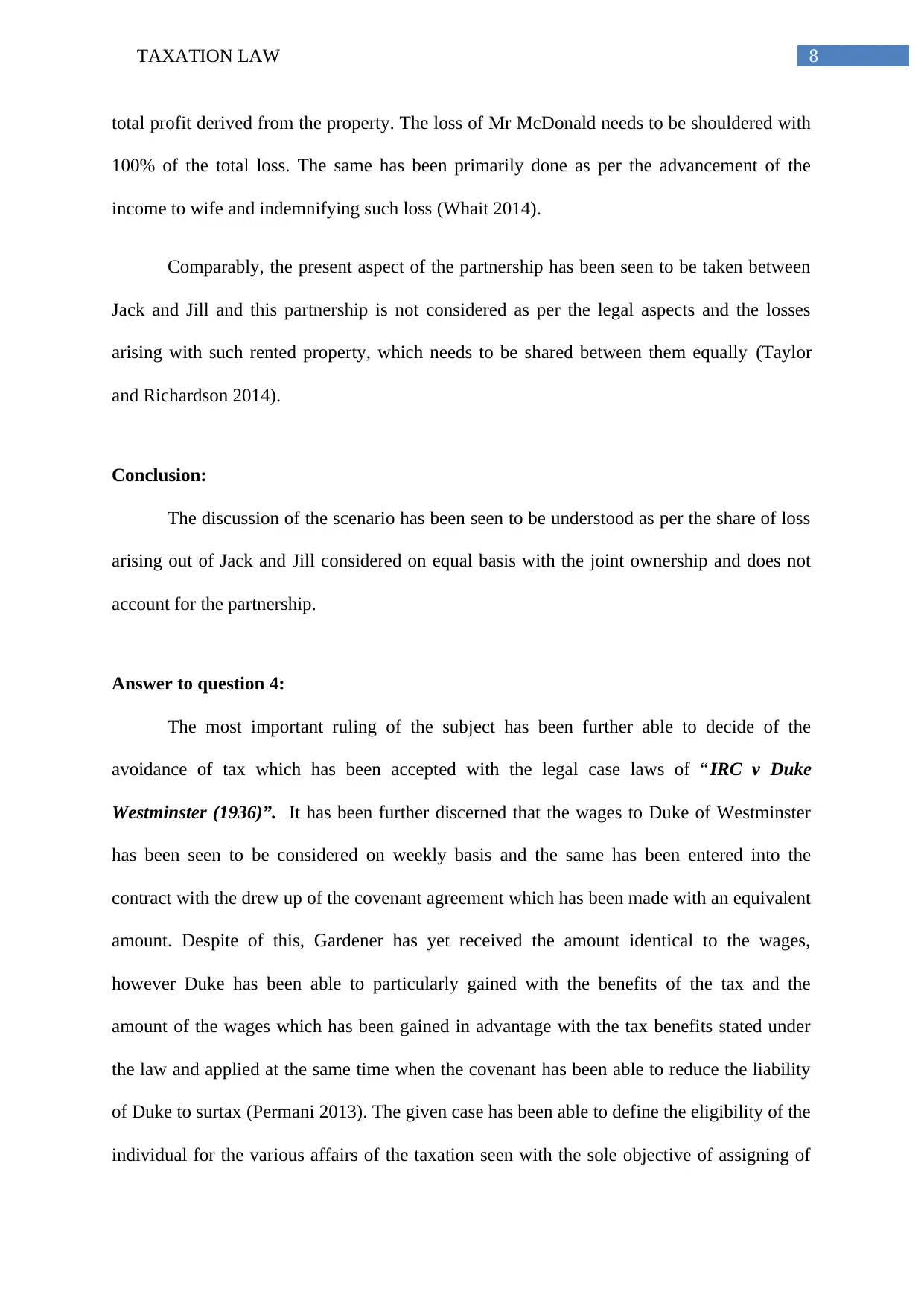
8TAXATION LAW
total profit derived from the property. The loss of Mr McDonald needs to be shouldered with
100% of the total loss. The same has been primarily done as per the advancement of the
income to wife and indemnifying such loss (Whait 2014).
Comparably, the present aspect of the partnership has been seen to be taken between
Jack and Jill and this partnership is not considered as per the legal aspects and the losses
arising with such rented property, which needs to be shared between them equally (Taylor
and Richardson 2014).
Conclusion:
The discussion of the scenario has been seen to be understood as per the share of loss
arising out of Jack and Jill considered on equal basis with the joint ownership and does not
account for the partnership.
Answer to question 4:
The most important ruling of the subject has been further able to decide of the
avoidance of tax which has been accepted with the legal case laws of “IRC v Duke
Westminster (1936)”. It has been further discerned that the wages to Duke of Westminster
has been seen to be considered on weekly basis and the same has been entered into the
contract with the drew up of the covenant agreement which has been made with an equivalent
amount. Despite of this, Gardener has yet received the amount identical to the wages,
however Duke has been able to particularly gained with the benefits of the tax and the
amount of the wages which has been gained in advantage with the tax benefits stated under
the law and applied at the same time when the covenant has been able to reduce the liability
of Duke to surtax (Permani 2013). The given case has been able to define the eligibility of the
individual for the various affairs of the taxation seen with the sole objective of assigning of
total profit derived from the property. The loss of Mr McDonald needs to be shouldered with
100% of the total loss. The same has been primarily done as per the advancement of the
income to wife and indemnifying such loss (Whait 2014).
Comparably, the present aspect of the partnership has been seen to be taken between
Jack and Jill and this partnership is not considered as per the legal aspects and the losses
arising with such rented property, which needs to be shared between them equally (Taylor
and Richardson 2014).
Conclusion:
The discussion of the scenario has been seen to be understood as per the share of loss
arising out of Jack and Jill considered on equal basis with the joint ownership and does not
account for the partnership.
Answer to question 4:
The most important ruling of the subject has been further able to decide of the
avoidance of tax which has been accepted with the legal case laws of “IRC v Duke
Westminster (1936)”. It has been further discerned that the wages to Duke of Westminster
has been seen to be considered on weekly basis and the same has been entered into the
contract with the drew up of the covenant agreement which has been made with an equivalent
amount. Despite of this, Gardener has yet received the amount identical to the wages,
however Duke has been able to particularly gained with the benefits of the tax and the
amount of the wages which has been gained in advantage with the tax benefits stated under
the law and applied at the same time when the covenant has been able to reduce the liability
of Duke to surtax (Permani 2013). The given case has been able to define the eligibility of the
individual for the various affairs of the taxation seen with the sole objective of assigning of
⊘ This is a preview!⊘
Do you want full access?
Subscribe today to unlock all pages.

Trusted by 1+ million students worldwide
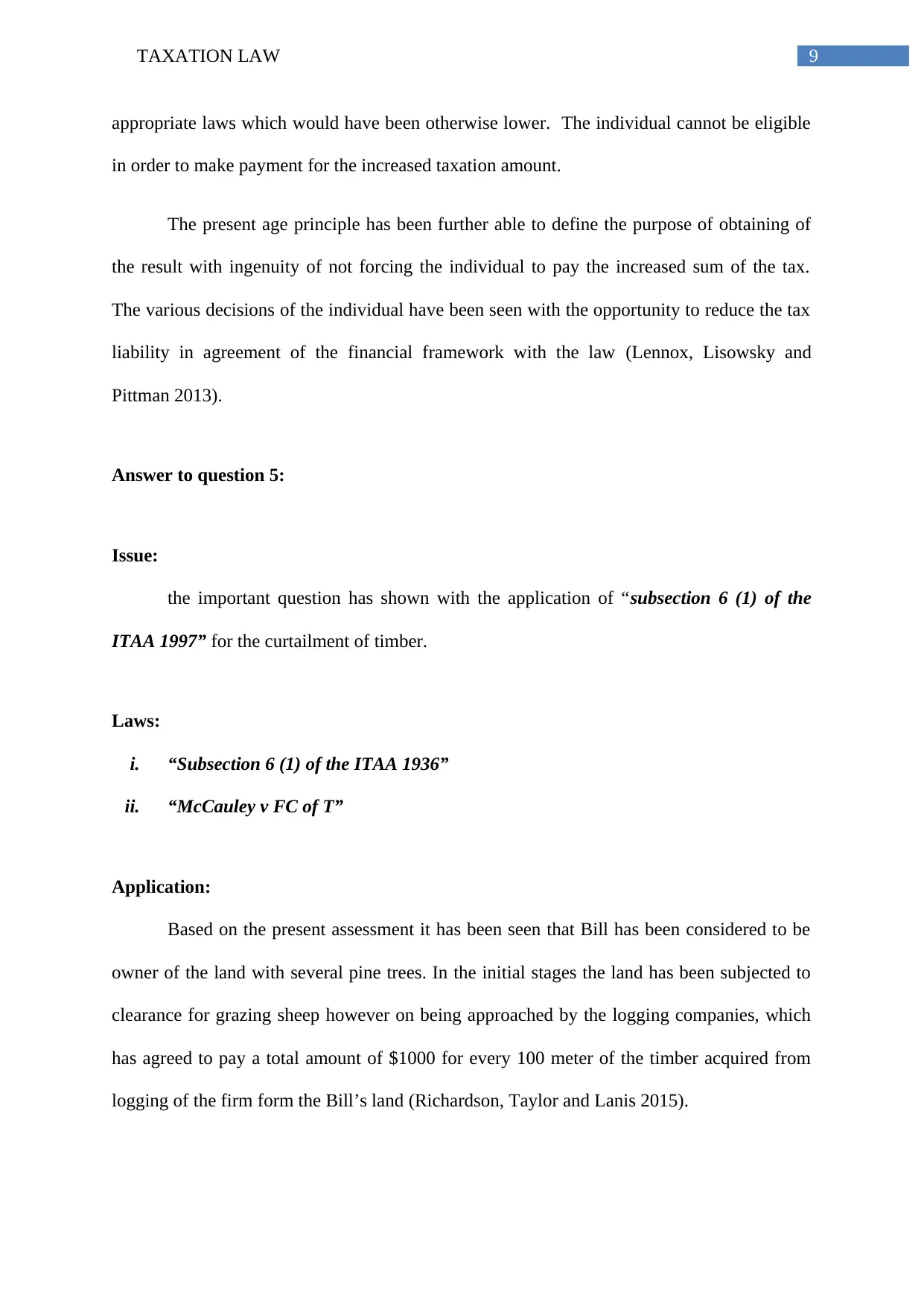
9TAXATION LAW
appropriate laws which would have been otherwise lower. The individual cannot be eligible
in order to make payment for the increased taxation amount.
The present age principle has been further able to define the purpose of obtaining of
the result with ingenuity of not forcing the individual to pay the increased sum of the tax.
The various decisions of the individual have been seen with the opportunity to reduce the tax
liability in agreement of the financial framework with the law (Lennox, Lisowsky and
Pittman 2013).
Answer to question 5:
Issue:
the important question has shown with the application of “subsection 6 (1) of the
ITAA 1997” for the curtailment of timber.
Laws:
i. “Subsection 6 (1) of the ITAA 1936”
ii. “McCauley v FC of T”
Application:
Based on the present assessment it has been seen that Bill has been considered to be
owner of the land with several pine trees. In the initial stages the land has been subjected to
clearance for grazing sheep however on being approached by the logging companies, which
has agreed to pay a total amount of $1000 for every 100 meter of the timber acquired from
logging of the firm form the Bill’s land (Richardson, Taylor and Lanis 2015).
appropriate laws which would have been otherwise lower. The individual cannot be eligible
in order to make payment for the increased taxation amount.
The present age principle has been further able to define the purpose of obtaining of
the result with ingenuity of not forcing the individual to pay the increased sum of the tax.
The various decisions of the individual have been seen with the opportunity to reduce the tax
liability in agreement of the financial framework with the law (Lennox, Lisowsky and
Pittman 2013).
Answer to question 5:
Issue:
the important question has shown with the application of “subsection 6 (1) of the
ITAA 1997” for the curtailment of timber.
Laws:
i. “Subsection 6 (1) of the ITAA 1936”
ii. “McCauley v FC of T”
Application:
Based on the present assessment it has been seen that Bill has been considered to be
owner of the land with several pine trees. In the initial stages the land has been subjected to
clearance for grazing sheep however on being approached by the logging companies, which
has agreed to pay a total amount of $1000 for every 100 meter of the timber acquired from
logging of the firm form the Bill’s land (Richardson, Taylor and Lanis 2015).
Paraphrase This Document
Need a fresh take? Get an instant paraphrase of this document with our AI Paraphraser
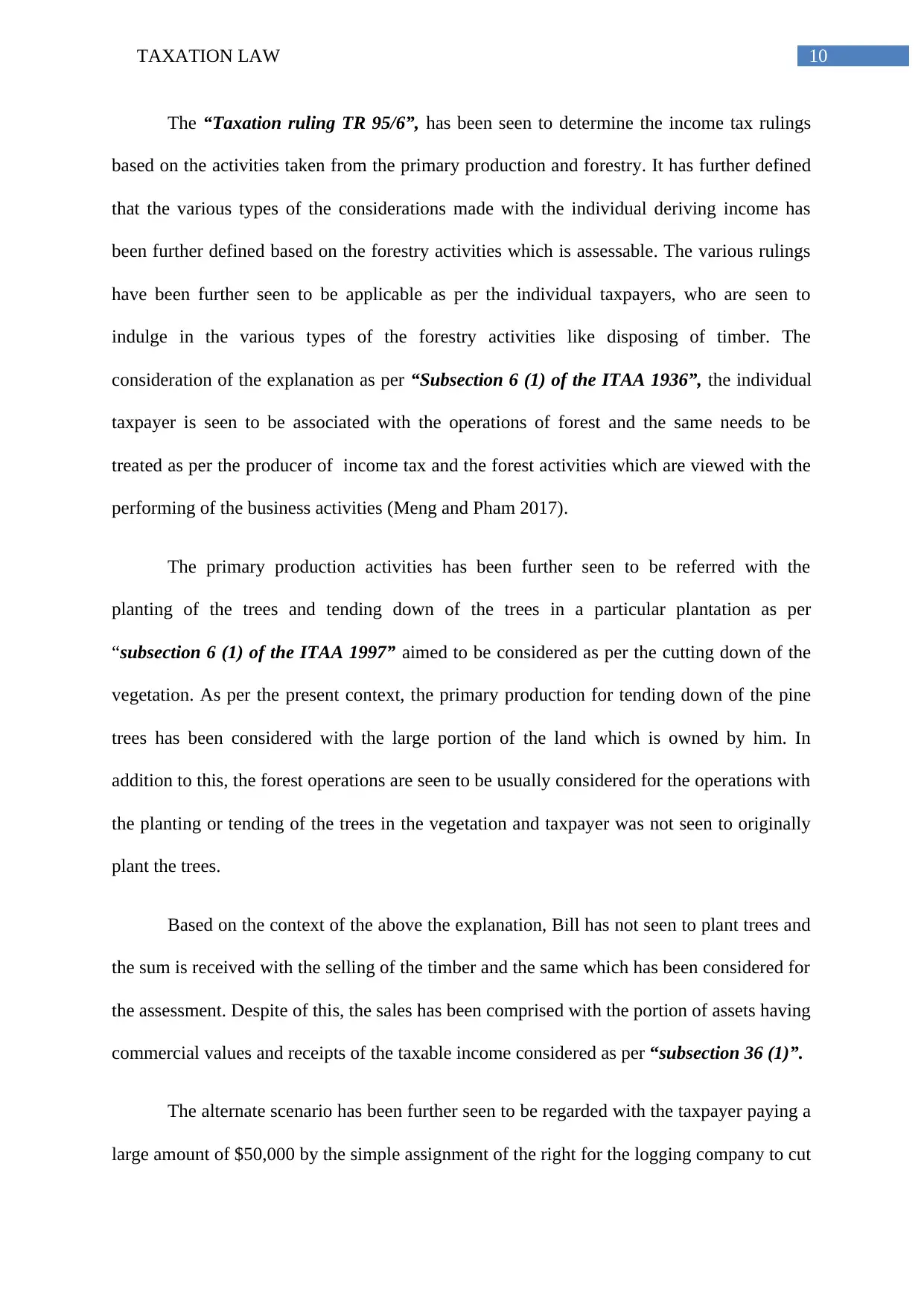
10TAXATION LAW
The “Taxation ruling TR 95/6”, has been seen to determine the income tax rulings
based on the activities taken from the primary production and forestry. It has further defined
that the various types of the considerations made with the individual deriving income has
been further defined based on the forestry activities which is assessable. The various rulings
have been further seen to be applicable as per the individual taxpayers, who are seen to
indulge in the various types of the forestry activities like disposing of timber. The
consideration of the explanation as per “Subsection 6 (1) of the ITAA 1936”, the individual
taxpayer is seen to be associated with the operations of forest and the same needs to be
treated as per the producer of income tax and the forest activities which are viewed with the
performing of the business activities (Meng and Pham 2017).
The primary production activities has been further seen to be referred with the
planting of the trees and tending down of the trees in a particular plantation as per
“subsection 6 (1) of the ITAA 1997” aimed to be considered as per the cutting down of the
vegetation. As per the present context, the primary production for tending down of the pine
trees has been considered with the large portion of the land which is owned by him. In
addition to this, the forest operations are seen to be usually considered for the operations with
the planting or tending of the trees in the vegetation and taxpayer was not seen to originally
plant the trees.
Based on the context of the above the explanation, Bill has not seen to plant trees and
the sum is received with the selling of the timber and the same which has been considered for
the assessment. Despite of this, the sales has been comprised with the portion of assets having
commercial values and receipts of the taxable income considered as per “subsection 36 (1)”.
The alternate scenario has been further seen to be regarded with the taxpayer paying a
large amount of $50,000 by the simple assignment of the right for the logging company to cut
The “Taxation ruling TR 95/6”, has been seen to determine the income tax rulings
based on the activities taken from the primary production and forestry. It has further defined
that the various types of the considerations made with the individual deriving income has
been further defined based on the forestry activities which is assessable. The various rulings
have been further seen to be applicable as per the individual taxpayers, who are seen to
indulge in the various types of the forestry activities like disposing of timber. The
consideration of the explanation as per “Subsection 6 (1) of the ITAA 1936”, the individual
taxpayer is seen to be associated with the operations of forest and the same needs to be
treated as per the producer of income tax and the forest activities which are viewed with the
performing of the business activities (Meng and Pham 2017).
The primary production activities has been further seen to be referred with the
planting of the trees and tending down of the trees in a particular plantation as per
“subsection 6 (1) of the ITAA 1997” aimed to be considered as per the cutting down of the
vegetation. As per the present context, the primary production for tending down of the pine
trees has been considered with the large portion of the land which is owned by him. In
addition to this, the forest operations are seen to be usually considered for the operations with
the planting or tending of the trees in the vegetation and taxpayer was not seen to originally
plant the trees.
Based on the context of the above the explanation, Bill has not seen to plant trees and
the sum is received with the selling of the timber and the same which has been considered for
the assessment. Despite of this, the sales has been comprised with the portion of assets having
commercial values and receipts of the taxable income considered as per “subsection 36 (1)”.
The alternate scenario has been further seen to be regarded with the taxpayer paying a
large amount of $50,000 by the simple assignment of the right for the logging company to cut
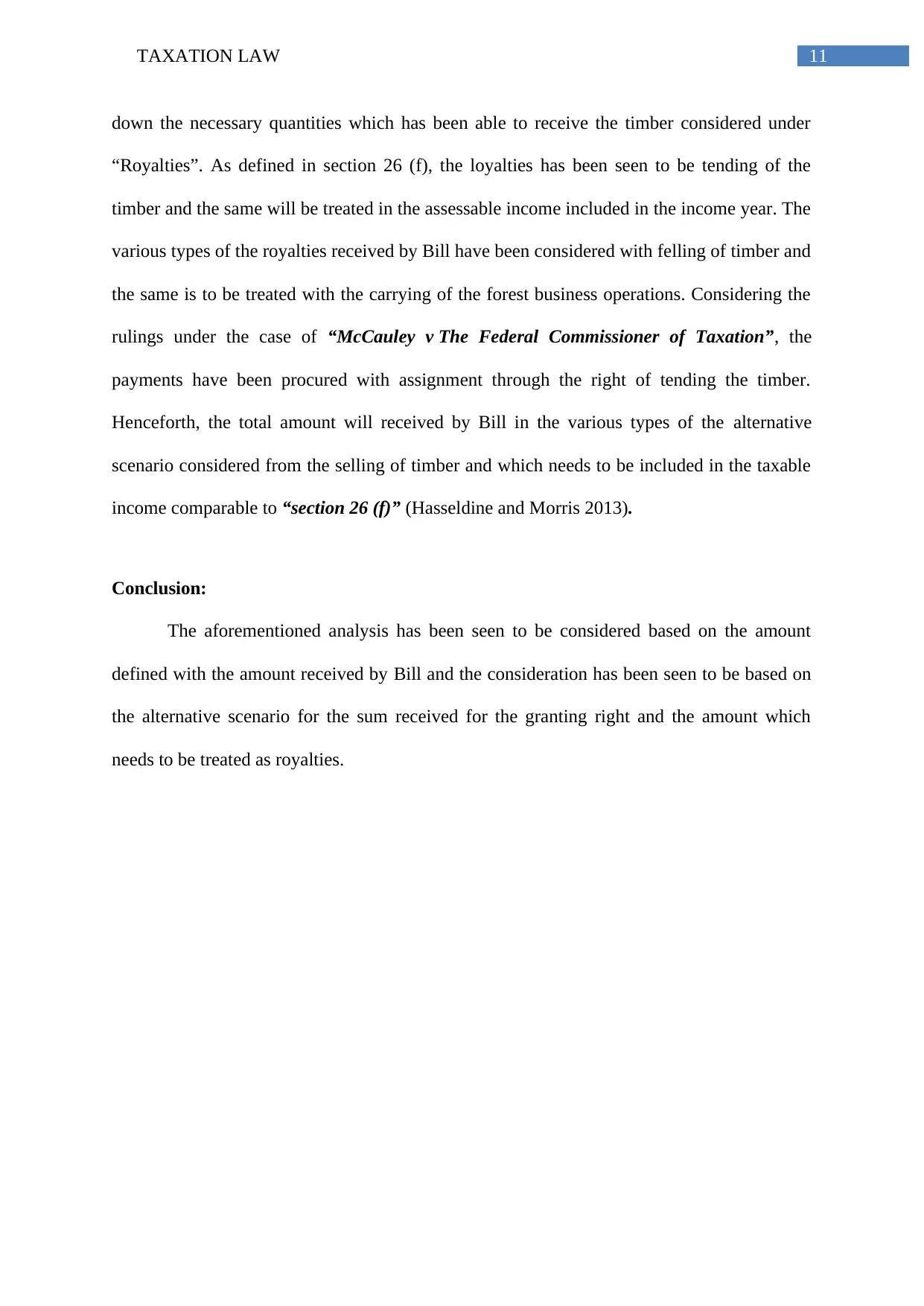
11TAXATION LAW
down the necessary quantities which has been able to receive the timber considered under
“Royalties”. As defined in section 26 (f), the loyalties has been seen to be tending of the
timber and the same will be treated in the assessable income included in the income year. The
various types of the royalties received by Bill have been considered with felling of timber and
the same is to be treated with the carrying of the forest business operations. Considering the
rulings under the case of “McCauley v The Federal Commissioner of Taxation”, the
payments have been procured with assignment through the right of tending the timber.
Henceforth, the total amount will received by Bill in the various types of the alternative
scenario considered from the selling of timber and which needs to be included in the taxable
income comparable to “section 26 (f)” (Hasseldine and Morris 2013).
Conclusion:
The aforementioned analysis has been seen to be considered based on the amount
defined with the amount received by Bill and the consideration has been seen to be based on
the alternative scenario for the sum received for the granting right and the amount which
needs to be treated as royalties.
down the necessary quantities which has been able to receive the timber considered under
“Royalties”. As defined in section 26 (f), the loyalties has been seen to be tending of the
timber and the same will be treated in the assessable income included in the income year. The
various types of the royalties received by Bill have been considered with felling of timber and
the same is to be treated with the carrying of the forest business operations. Considering the
rulings under the case of “McCauley v The Federal Commissioner of Taxation”, the
payments have been procured with assignment through the right of tending the timber.
Henceforth, the total amount will received by Bill in the various types of the alternative
scenario considered from the selling of timber and which needs to be included in the taxable
income comparable to “section 26 (f)” (Hasseldine and Morris 2013).
Conclusion:
The aforementioned analysis has been seen to be considered based on the amount
defined with the amount received by Bill and the consideration has been seen to be based on
the alternative scenario for the sum received for the granting right and the amount which
needs to be treated as royalties.
⊘ This is a preview!⊘
Do you want full access?
Subscribe today to unlock all pages.

Trusted by 1+ million students worldwide
1 out of 14
Related Documents
Your All-in-One AI-Powered Toolkit for Academic Success.
+13062052269
info@desklib.com
Available 24*7 on WhatsApp / Email
![[object Object]](/_next/static/media/star-bottom.7253800d.svg)
Unlock your academic potential
Copyright © 2020–2025 A2Z Services. All Rights Reserved. Developed and managed by ZUCOL.





